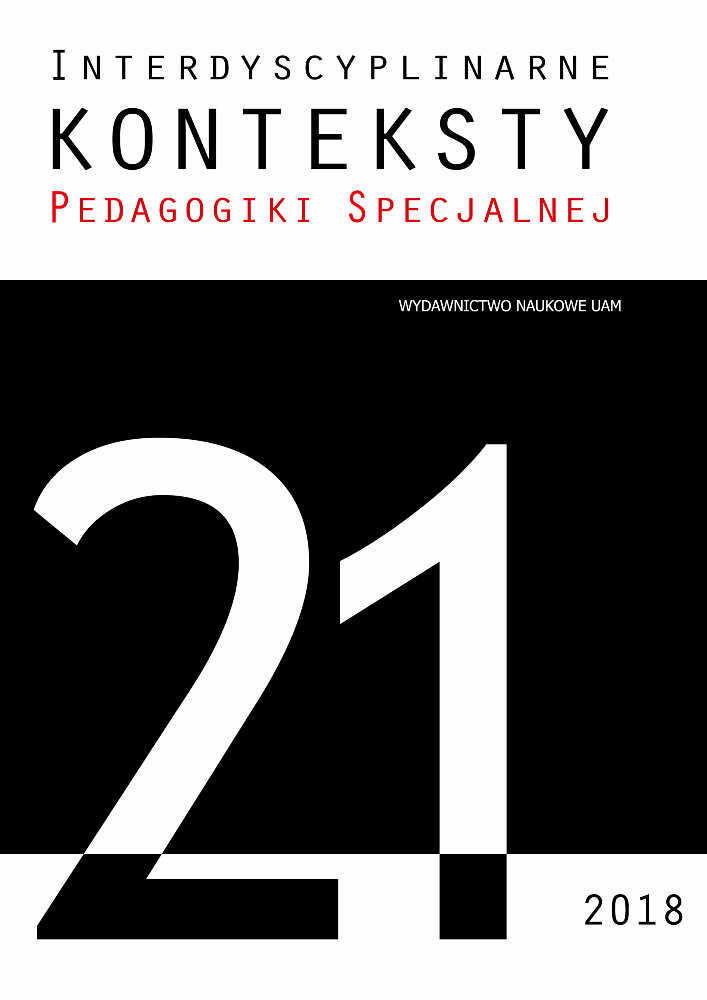Abstract
The paper concerns foreign language typhlomethodology and presents an overview of available research findings in the field, arranged in chronological order. The studies discussed in the paper have insight into either first language acquisition or foreign language learning by visually impaired learners. The former shed light on the potential problems the visually impaired might have while learning foreign languages. The problems might emerge both in the phonological or semantic domain. The latter, in turn, discuss such issues as the use of foreign language vocabulary learning strategies and the role of affective factors which facilitate the language learning process. Nowadays the European Union promotes ‘Languages to All’ principle, i.e. teaching languages to all groups of learners, regardless of their disabilities and impairments, preferably in inclusive education setting. Therefore, foreign language teachers should be acquainted with the research findings and their implications presented herein.
References
H. Aikin Araluce, Teaching English as a foreign language to blind and visually impaired young learners: the affective factor. Praca doktorska na Universidad de Castilla-LaMancha, Cuenca w Hiszpanii, 2005.
K. Czerwińska, Języki obce a osoby z dysfunkcją wzroku. Publikacja z funduszy projektu Per lingua mundi ad laborem. Wydawnictwo Akademii Pedagogiki Specjalnej, Warszawa, 2008.
L. Dorstet, The blind learn Russian in Georgetown University, New Beacon, Washington DC, 1963.
A. Dunlea, Vision and the emergence of meaning blind and sighted children’s early language. Cambridge University Press, Cambridge, 1989.
L.J. Flood, The value of Latin in schools for the blind. Referat przedstawiony na 32 Konwencji Amerykańskiego Stowarzyszenia Nauczycieli Osób Niewidomych, 1934.
S. Fraiberg, Insights from the Blind. Basic Books, New York i St Louis, Missouri Blind, 1977.
H. Guinan, H. ESL for students with visual impairments. „Journal of Visual Impairment and Blindness”, 1997, nr 91, s. 555-564.
M. Jedynak, Analysis of Mental Lexicon in Sighted and Blind Children on the Basis of Prototypes. Referat wygłoszony na Międzynarodowej konferencji naukowej Koncepcje w edukacji językowej w kontekście regionalnym i europejskim w Jeleniej Górze w dniach17-18 października, 2008.
M. Jedynak, Językowe odwzorowanie rzeczywistości przez niewidomych i widzących użytkowników języka polskiego. „Rozprawy Komisji Językowej” XXXVIII. Wrocławskie Towarzystwo Naukowe, Wrocław, 2011, s. 61-73
M. Jedynak, Wpływ nabywania języka pierwszego przez niewidome dzieci na naukę języka drugiego – implikacje dydaktyczne dla nauczycieli języków obcych , [w:] PLEY, PsychoLingwistyczne Eksploracje Językowe, red. O. Majchrzak, Wydział Filologiczny Uniwersytetu Łódzkiego, Łódź:, s. 39-55, 2014.
M. Jedynak, 2015. Visually impaired learners and selected correlates of their foreign language achievement. Wydawnictwo Uniwersytetu Wrocławskiego, Wrocław.
H. Komorowska, 2004. Metodyka nauczania języków obcych. Warszawa: Fraszka Edukacyjna. Komisja Europejska. Raport. Special Educational Needs in Europe. The Teaching and Learning of Languages. Insights and Innovation. Teaching Languages to Learners with Special Needs. DG EAC 23 03 LOT 3, 2005.
T.P. Krzeszowski, Niewidomi a języki obce, czyli kilka słów o tyfloglottodydaktyce. „Języki Obce w Szkole”, Wydanie specjalne 7: Nauczanie języków obcych uczniów niepełnosprawnych. Ośrodek Rozwoju Edukacji, Warszawa: 2001, s. 5-12.
B. Marek, 2000a. Teaching visually impaired students in Poland. Online interview, http://www.unicef.org/teachers/forum/0300.htm [dostęp: 09.01.2018]
B. Marek, 2000b. Visions and strategies for the new century. Materiały pokonferencyjne z Konferencji Europejskiej, Kraków 9 -13 lipiec 2000, http://www.hungryfingers.com/learning.html [dostęp: 05.01.2018]
H. McColl, 2000. Modern languages for all. Entitlement for All Series. David Fulton Publishers, Oxford: R. McDonald, 1968. A Report on Special Intensive Language. Courses for the Blind. Georgetown University Institute for Language and Linguistics, Washington DC.
A.E. Mills, The development of phonology in the blind child, [w:] Hearing by Eye: The Psychology of Lip-Reading, red. B. Dodd i R. Campbell, London: Lawrence Erlbaum Associates, 1983, s. 145–163.
W.P. Morrissey, Teaching Foreign Languages in Schools for the Blind. The Teachers Forum, Nov. 1931.
J. M., O’Malley, A. Chamot, G. Stewner-Manzanares, L. Kupper, R. Russo, Learning strategies used by beginning and intermediate ESL students. „Language Learning”, 1985, 35/1, s. 21-46.
R. Oxford, Language learning strategies: What every teacher should know, New York, USA: Newbury House, 1990.
J. Rubin, J. What the good language learner can teach us, TESOL Quarterly, 1981, nr 9: 1, s. 41-51.
A. Wesołowska, M. Jedynak, FL Vocabulary Learning Strategies Used by Blind, Partially Blind and Normally Sighted Learners of English In Teaching Languages off the Beaten Track. [w:] Language Learning & Language Teaching series, red. M. Paradowski, Peter Lang, Frankfurt am Main, 2014, s. 306-328.
B. Wyszyńska, Teaching English as a foreign language to the visually impaired. A recharged Direct Method. Nieopublikowana praca doktorska. Akademia Nauk w Łodzi, 2013.

